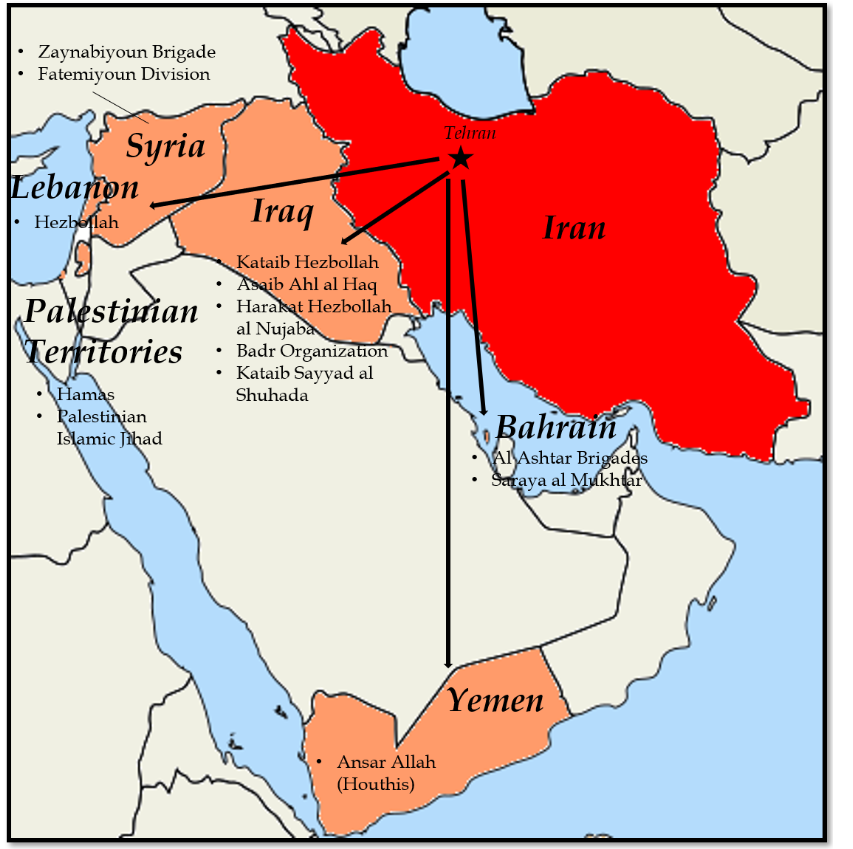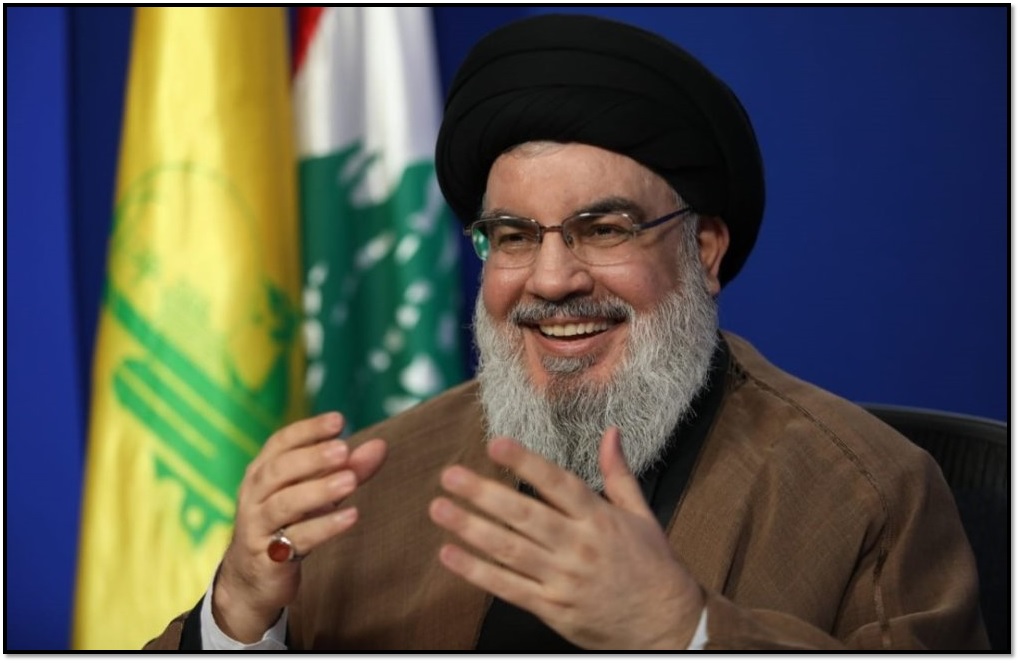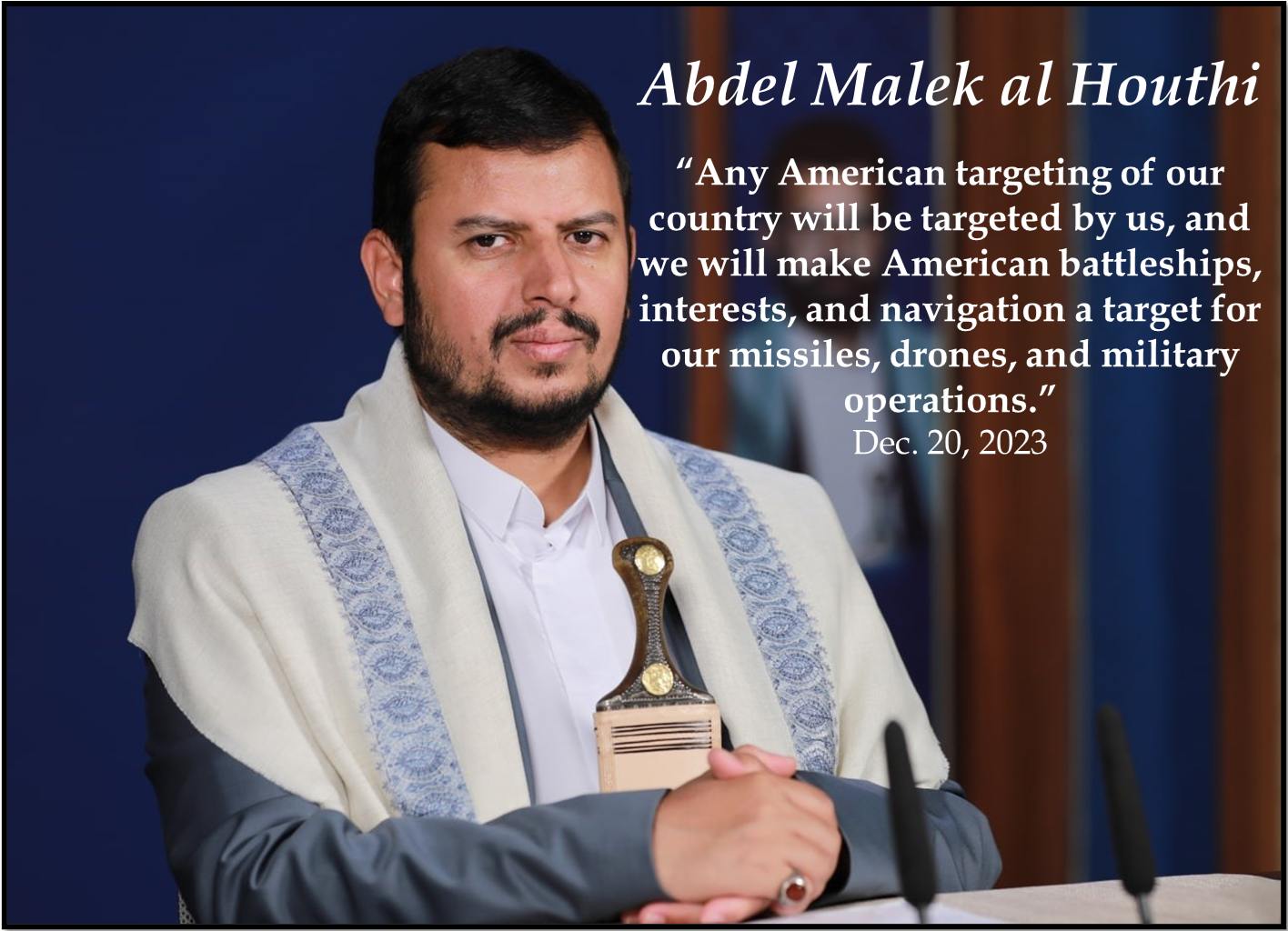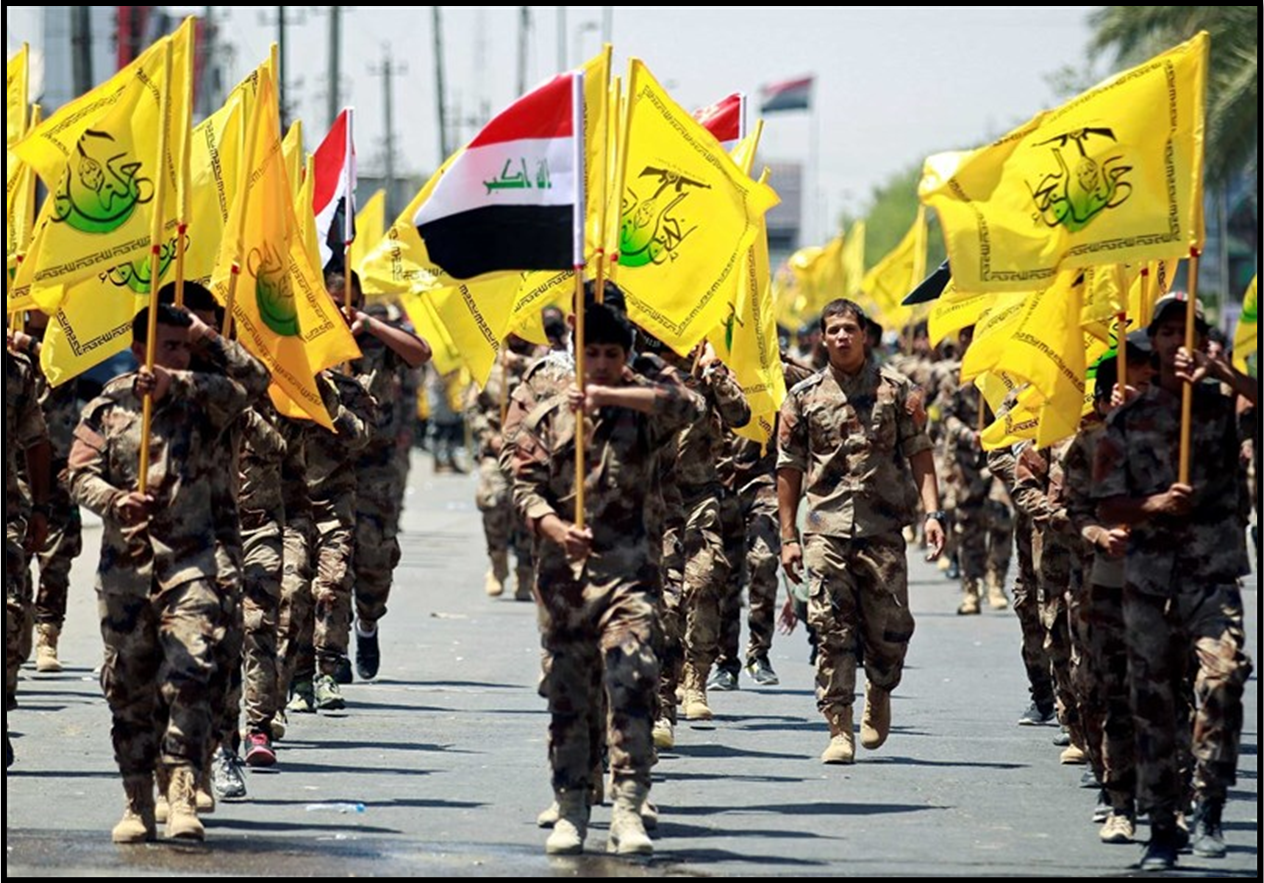Iran has armed, trained and funded militias movements since the 1979 revolution. It fostered allies, such as Hezbollah in Lebanon and disparate Shiite militias in Iraq, from their early days. It also tapped into existing groups with overlapping goals, including Hamas and Palestinian Islamic Jihad in the Palestinian territories, and the Houthis in Yemen. Tehran allied with the Assad dynasty in Syria, where Iran built a separate network of sympathizers, arms facilitators, and fighters. Together, they have all evolved into the so-called “Axis of Resistance.”
Iran’s relationship has varied with each ally. The militias, especially those with political wings, have had local constituencies and agendas. Hezbollah chief Hassan Nasrallah has repeatedly countered charges that the movement was strictly an Iranian proxy. “Hezbollah is not an Iranian community in Lebanon, and its fighters are not Iranian citizens,” he said in September 1992. In late 2017, Hashem al Mousawi, a spokesman for Harakat Hezbollah al Nujaba, an Iraqi militia, downplayed the group’s loyalty to Iran’s supreme leader. “We don’t belong to Iran,” he told The Christian Science Monitor. In December 2023, Houthi spokesperson Mohammad Abdulsalam said, “We do not take orders from Iran. I must emphasize that the Yemeni people have dignity.”

Beyond Syria, the Islamic republic has lacked strong alliances at the state level, so it has leveraged non-state militias to expand its sphere of influence, promote its security interests, and spread its distinct Shiite ideology. Tehran’s “forward defense” doctrine more often threatened Israeli, U.S. and Western targets indirectly through the Axis of Resistance members rather than directly.
The Axis has vowed to coordinate operations against Israel, since the Gaza war between Hamas and Israel erupted in October 2023. They pledged revenge for the reported Israeli assassinations of Hezbollah commander Fuad Shukr in Beirut on July 27 and Hamas political leader Ismail Haniyeh during his visit to Iran on July 31, 2024. “All fronts of the resistance will take revenge for Haniyeh's blood,” warned Ali Akbar Ahmadian, the secretary of Iran's Supreme National Security Council. The following are profiles of Iran’s three most important military allies.
Hezbollah
Hezbollah emerged after Israel’s 1982 invasion of Lebanon amid the chaos of a civil war. Iran dispatched some 1,500 trainers and advisers to Lebanon’s eastern Bekaa Valley in the 1980s to mobilize, train, fund and arm a new underground militia that evolved into Hezbollah. In its early years, the Shiite movement launched attacks against Israeli and Western forces, including two U.S. embassies and U.S. Marine peacekeepers. Its guerrilla tactics, including suicide bombings, eventually pushed U.S. forces to leave in 1984 and Israel to fully withdraw in 2000.
The Shiite movement evolved from a shadowy militia to become a political powerbroker in the Middle East and the world’s most heavily armed non-state actor.

Hezbollah hardened its defenses and trained its fighters in new tactics. During the 2006 war, it fired some 4,000 rockets at Israel during the 34-day conflict. It also launched three drones at strategic sites in Israel and hit an Israeli warship with an explosive-laden drone. “Today we can say proudly that if any Israeli government decides to launch war in the future, it will take into consideration that war with Lebanon will not be a picnic,” Secretary General Hassan Nasrallah said in August 2006 after the war ended.
By mid-2024, Hezbollah had evolved into a militia more capable than many armies in the Middle East. It had four decades of operational experience both inside Lebanon and elsewhere in the Middle East, especially Syria. U.S. intelligence estimated that Hezbollah had 45,000 fighters, 20,000 of whom were full-time.
Over the decades, Hezbollah amassed a diverse arsenal of weapons, largely with the assistance of Iran. As of 2024, its rocket and missile arsenal was estimated to range from 75,000 to 200,000 rockets and missiles. Hezbollah also had approximately 2,500 drones, including models that could attack or surveil targets hundreds of miles away. In June 2024, U.S. officials assessed that some of Israel’s Iron Dome batteries could be overwhelmed in a full-scale war with Hezbollah.
Between October 2023 and late July 2024, Hezbollah launched more than 6,000 rockets and 300 drones at Israel, killing 24 civilians and 22 Israeli soldiers. On July 30, 2024, tensions rose after an Israeli airstrike killed Fuad Shukr, who served on Hezbollah’s Jihad Council and was a close advisor to Nasrallah, in the southern suburbs of Beirut, the Lebanese capital. Israel blamed Shukr for an attack on Majdal Shams—a Druze town in the Israeli-occupied Golan Heights—that killed 12 children and teenagers on July 27.
Nasrallah pledged “inevitable retaliation” during a speech on August 1. He warned that Israel had crossed Hezbollah’s red lines and that the conflict had entered a new phase. Israel “does not know where the retaliation will come from, whether from the north or the south of Palestine, and whether it will be separate from or simultaneous” with operations in other fronts.”
Houthis
The Houthis emerged out of a religious revival among Yemen’s Zaydi Shiites in the 1990s. It evolved into a political movement and militia. In 2004, the Houthis challenged the Yemeni central government, which had long been dominated by Sunnis, in sporadic waves of fighting.
Tehran started transferring weapons to the Houthis by 2009, when Riyadh was drawn into the conflict between the Houthis and Yemen’s pro-Saudi central government. For years, the Houthis were the most peripheral of Iran’s network of allies in the Axis of Resistance. But growing turmoil in Yemen, after the 2011-12 Arab uprising ousted a president closely aligned with Saudi Arabia, increasingly made Yemen a regional flashpoint. It embodied tensions between predominantly Shiite Iran and Saudi Arabia, a Sunni monarchy and the guardian of Islam’s holy places. In 2014, the Houthis seized Sanaa, Yemen’s capital, and toppled the central government. In response, Saudi Arabia and the United Arab Emirates launched an intensive air war in 2015.
The Houthis used its “growing arsenal of sophisticated weapons and training” provided by Iran to attack opponents as well as international shipping along its coasts on the Red Sea and the Gulf of Aden, according to the U.S. Defense Intelligence Agency. Iran began sending ballistic and cruise missiles to the Houthis by 2015 and advanced drones by 2017. The Houthis amassed missiles with claimed ranges of 2,000 kilometers (1,200 miles) and aerial drones with claimed ranges of up to 2,500 kilometers (1,500 miles). Iranian weapons – along with Iranian and Hezbollah military advisors – helped transform the scrappy tribal militia into a well-armed and disciplined fighting force. The group had at least 20,000 fighters.

The Houthis saw an opportunity to raise their international profile as soon as war broke out between Hamas and Israel in October 2023. First, they fired missiles and drones at Israel, more than 1,000 miles away from Yemen. Then they launched attacks on merchant and U.S. warships in the Red Sea and Gulf of Aden, effectively impeding commercial Red Sea shipping, which accounted for 15 percent of global seaborne trade. Houthi hostilities in the Red Sea soon constituted one of the most significant global reverberations emanating from the Gaza conflict. The Houthis posed the biggest international threat from Iran’s network of allies.
During the first eight months of the conflict, the Houthis attacked U.S. Navy or commercial vessels more than 190 times, according to the Pentagon. The U.S. Navy had not been involved in such heated combat since World War II, according to Vice Adm. Brad Cooper. U.S. and coalition partners not only intercepted incoming projectiles, they launched airstrikes on Houthi missiles, launchers, drones, storage facilities, communications buildings and other targets.
The Houthis fired more than 200 cruise missiles, ballistic missiles and drones at Israel during the first nine months of the Gaza conflict. They primarily targeted Eilat, the strategic Israeli port on the Red Sea that is roughly 1,000 miles from Sanaa.
Houthi leader Abdel Malik al Houthi pledged retaliation against Israel for Haniyeh’s death. “We will spare no effort, with God's permission and in cooperation with our brothers in the Resistance Axis, in avenging the martyr and all the martyrs and the injustice suffered by the Palestinian people,” al Houthi said on July 31, 2024.
Islamic Resistance in Iraq
The Islamic Resistance in Iraq (IRI), a general term for Iraqi Shiite militias backed by Iran, emerged after war between Hamas and Israel erupted on Oct. 7, 2023. The militias expressed solidarity with the Palestinians and condemned the United States for supporting Israel. The IRI included groups that had been armed, trained and funded by Tehran for years. At least four were part of Iraq’s Popular Mobilization Forces (PMF), an umbrella group formed in mid-2014 to combine more than 60 old and new militias after ISIS captured a third of Iraq. In 2016, the PMF were formally integrated into Iraq’s security forces, but some militias were only nominally under Baghdad’s control.

Iraqi Shiite militias sporadically attacked bases in Iraq and Syria that hosted U.S. forces after ISIS lost its last territory in Iraq in November 2017. They demanded that U.S. forces withdraw from Iraq. But they largely paused their attacks in late 2022 after the formation of the Iraqi government under Prime Minister Mohammed Shia al Sudani, a Shiite who had good relations with neighboring Iran, a predominantly Shiite country. The IRI included at least four militias that had previously attacked U.S. forces:
- Kataib Hezbollah, or the Brigades of the Party of God (PMF Brigade 45, 56 and 57) formed in 2004, when the Shiite militias began attacks on the U.S.-led coalition. Five small armed groups united to form Kataib Hezbollah in 2007 under the tutelage of Iran, which provided weapons, funding and military advice; some of its fighters trained in Iran. Its fighters were held responsible for attacks on the U.S.-led coalition in Iraq. After the 2011 U.S. withdrawal from Iraq, Kataib Hezbollah dispatched fighters to defend the Assad regime in Syria at the behest of Iran. Kataib Hezbollah joined the PMF 2014. It has been responsible for some of the deadliest attacks on U.S. forces. As of 2022, the Director of National Intelligence estimated that Kataib Hezbollah had up to 10,000 fighters. The group possessed rockets, short-range ballistic missiles and drones.
- Harakat Hezbollah al Nujaba (HHN), or Movement of the Party of God’s Nobles (PMF Brigade 12) was an offshoot of Kataib Hezbollah and Asaib Ahl al Haq, another Iran-backed militia. HHN formed in 2013 to support the Assad regime in Syria. In 2014, its mission expanded to fight ISIS. HHN leaders have publicly acknowledged Iran’s support. As of 2019, HHN had an estimated 10,000 fighters. It possessed drones and rockets.
- Kataib Sayyad al Shuhada (KSS), or The Masters of the Martyrs Brigade (PMF Brigade 14) formed in May 2013 to fight alongside the Assad regime in Syria. Similar to HHN, KSS expanded its operations to Iraq after the rise of ISIS in 2014. KSS has been supported and funded by the IRGC since its inception. Abu Ala al Walai, who fought against Saddam Hussein’s regime, has led the group since 2014.
- Ansar Allah al Awfiya (AAA), or God’s Loyal Supporters (PMF Brigade 19), formed in 2013 as a political organization under the name, Kayan al Sadiq wa al Ataa, or Honesty and Giving Entity. It morphed into AAA and became a PMF unit in June 2014. The group has attacked U.S. forces. Haydar Muzhir Malak al Saidi was the militia’s secretary general.
The militias under the IRI umbrella launched more than 160 rocket and drone attacks on U.S. forces during the first four months of the Gaza conflict from October 2023 to February 2024. Tensions flared between the United States and allies of Iran after a drone attack killed three American soldiers and injured more than 40 at Tower 22, a military outpost in northern Jordan on Jan. 28, 2024. Kataib Hezbollah, the most powerful IRI militia, announced a pause on attacks, reportedly at Iran’s request. On Feb. 7, 2024, a U.S. airstrike killed Abu Baqir al Saadi, a senior commander in Kataib Hezbollah linked to the attack on Tower 22.
The IRI did not launch attacks on U.S. forces again until April 2024. By August, the militias had launched more than 180 attacks on U.S. forces in the region since the start of the Gaza war, according to the Pentagon. The IRI also claimed more than 100 attacks on Israel, including a dozen coordinated with the Houthis, but the Israel Defense Forces rarely confirmed that attacks occurred. On April 1, 2024, a drone launched from Iraq hit a naval base near the southern port city of Eilat.
Militias in the IRI condemned Israel for assassinating Haniyeh and Shukr. “The Zionists and Americans have opened the doors of hell,” HHN said on July 31, 2024. Kataib Hezbollah warned that Israel had violated “all the rules of engagement” and that men would “stand up to it and break its arrogance.”
